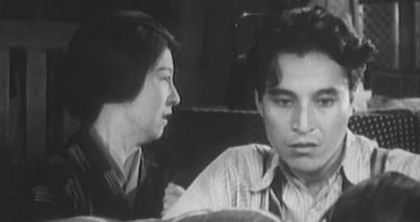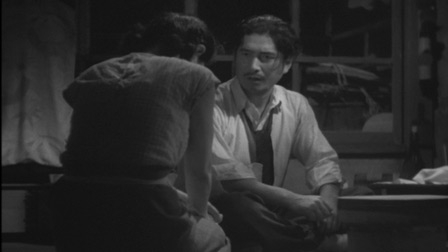This is the first thing I ever wrote about Ozu’s films. I’ve subsequently come to value Hen in the Wind much more than I did in 1972, above all as an expression of Japanese’s humiliation after the end of the war and during the American occupation. — J.R.
From Paris Journal, Film Comment, Summer 1972 (excerpt):
A recent screening of eight Ozu films at the Cinémathèque was, for Paris, an event of some importance. To date, not a single film by Ozu has received distribution in France, and local ignorance about his work extends to such places as Cahiers du Cinéma and Positif, which in their combined 368 issues have failed to publish a single article about him.
A particular revelation was WIFE FOR A NIGHT, which contradicted at least half of the received ideas that have been circulating about Ozu elsewhere. One of the ten silent films that he made in 1930, this remarkable American-style thriller begins and ends mainly in exteriors: a desperate robbery and escape at night, the criminal being led away at dawn. Virtually all of the intervening action is contained in the robber’s one-room flat, where he, his ailing daughter, his wife, and a policeman stand nervous vigil over one another for the night’s duration. Lateral pans and tracking shots –- always beginning or ending with an actor and combing the décor -– explore the tensions and intensify the clotted atmosphere, beading the characters and their surroundings on the same narrative-thematic threads.
The décor itself is an extraordinary assemblage suggesting both a studio stock room and a Sternbergian junkpile: posters of Hollywood films (BROADWAYS SCANDALS) and foreign countries (India), a full clothesline, an English motto scrawled in chalk (“Two’s company, three’s a crowd”), scattered snapshots and clogged ashtrays comprise only a fraction of the terrain. Recalling the travel posters on the claustrophobic stairway in Nicholas Ray’s BIGGER THAN LIFE, one quickly realizes that Ozu is using camera movements to express the same sort of relationships that Ray can show in Cinemascope with a motionless camera. And implausible as the connection might seem, the vastly different sensibilities of Ozu and Ray are linked by a common obsession: the importance of the horizontal line. (This connection may appear somewhat more plausible if we consider Ray’s statement that his “appreciation for the horizontal line” derives from his studies with Frank Lloyd Wright, and then acknowledge the almost exclusive influence of Japanese art and architecture on Wright’s own work.)
If I compare Ozu to an Occidental director — and many more such comparisons are to follow — this is not to overlook the fact that in Japan he is commonly considered the “most Japanese” of directors. But since Ozu is firmly labeled “esoteric” in the West, an examination of a few points of convergence with European and American directors may help to demonstrate that his social, aesthetic, and cultural orientations are not as remote to use as many have assumed. Indeed, rather than insist that Ozu can only be understood from a “Japanese viewpoint”, it is much more rewarding to assume that one’s own cultural biases are both necessary and adequate. In this context, it is worth noting that, according to Donald Richie, Ozu’s favorite film was CITIZEN KANE, and that he spoke with enthusiasm about Thomas Ince, Rex Ingram, Chaplin, and Ford; and the American posters in WIFE FOR A NIGHT are only a foretaste of the increasingly Americanized landscapes of Ozu’s later films, from various shots of Tokyo’s Time-Life building in the late 40s to the pastel-plastic colors and surfaces of EQUINOX FLOWER (1959).
For all the apparent stylistic differences between WIFE FOR A NIGHT and Ozu’s post-war films, they are clearly the work of the same man. The celebrated scene-setting shots in the later films, compressing a locale and milieu into a single emblematic image, are prefigured by the startling aptness of certain closeups that distill and abstract complex strains in the plot, such as a beautiful image of the robber’s hand fluttering nervously against the glass pane of a phone booth as he tries to place a call. And one could say that the stationary medium shots of the later period, which snugly frame the characters in their home environments, are themselves distillations of the horizontal linkage implied by the camera movements in WIFE.
By the time we reach LATE SPRING (1949) and EARLY SUMMER (1951), we arrive at the art of the necessary, where apparently minimal means are used from maximal effects. A cut from living room to suburban train in the first reel of EARLY SUMMER, in relation to the rest of the film, is as dynamic as the bone-to-spacecraft cut is to 2001. As with Tati, Ozu’s formalism and his absorption in the commonplace become almost indistinguishable, because each allows for the expression of the other: whether one speaks of social forms realized in cinematic terms or of cinematic forms realized in social terms, the process remains the same. And as with Bresson, the montage is linked as often by the sounds (or silences) as by the images; some of the earliest shots in EARLY SUMMER are fixed set-ups of an empty hallway and short tracks through an empty Noh theater, exquisitely timed cadences that punctuate the narrative with moments of repose.
To make another comparison with the American cinema, consider the identical “scenic” shot that opens and closes Leo McCarey’s monumental soap opera, AN AFFAIR TO REMEMBER: snow falling on an uninhabited spot in Central Park. The first time it occurs, apart from a vague setting of time (winter) and place (New York City), it is mere window-dressing for the credits; the second time, it immediately follows the climax of the film, the couple’s reassertion of their love — a moment of extraordinary emotional power — and the shot’s “emptiness” makes it work as an elegant sounding brass for what has just preceded it. Ozu’s use of “empty” shots is far more complex than McCarey’s — compositionally, rhythmically, and in terms of their recurrence — but they register as simply and as meaningfully. On the other hand, eliminate the theme music from McCarey’s last shot and you have an image as “abstract” and as emblematic as one of Ozu’s.
An unfortunate aspect of the Mizoguchi vs. Kurosawa debate is that Ozu’s singular virtues, falling within the range of neither director, usually get lost in the shuffle. In the least successful Ozu film that I’ve seen, Hen in the Wind (1948), a wife is forced into prostitution by poverty and a sick child while her husband is away in the army, and the plot chart’s the couple’s reconciliation after the husband returns and discovers the truth. If Kurosawa treated this subject, one would expect him to focus more on the husband’s war experience; Mizoguchi would likely devote more attention on the wife and her brief episode as a prostitute. Ozu, accepting the viewpoints of husband and wife equally, maintains this balance by showing us nothing of either the husband at war or the wife as a prostitute — both are left up to our imaginations and the characters’; we “see” the husband at war through his wife’s sorrows at home, the wife’s prostitution through the husband’s visit to the bordello after she has left.
The consistent use of a low, eye-level camera angle in the later works makes one realize that the eye level of most films is that of a standing spectator. But Ozu’s acknowledgment and use of the fact that we watch movies while seated is only one of his subtle strategies for drawing us into his tight family circles. Perhaps most striking of all is the absolutely equal distribution of love and generosity towards all of his characters — implicit in HEN IN THE WIND, but triumphant in such later masterpieces as LATE SPRING, EARLY SUMMER, and TOKYO STORY (1953).
There are no moral hierarchies — no heroes or villains, no privileged “choruses,” no comic relief (although much comedy), no subjective centers in which to locate our viewpoints. Dramatic focus is depolarized, and the characters are always too busy living to “explain” themselves. When Chishu Ryu sits with his two grandchildren at the base of a Buddha in a park, in EARLY SUMMER, there is no establishing shot to reveal either Buddha or the park its entirety; we see no more than the characters do. When, in the same film, someone remarks that “Tokyo’s an attractive city,” there is a cut to a view from the window of a city street that neither corroborates nor contradicts the statement. All is equal with Ozu, and — again, as with Tati — nothing bores him. The father trimming his toenails in LATE SPRING is a sublime moment.
A Preminger will accept and tolerate — even welcome — antagonistic points of view within a single shot so that he can watch them co-exist, mingle, synthesize, or compete for supremacy: “the American way”. Ozu cannot conceive of dualisms on this level because his characters are too complete — too much themselves — to stand for, represent, or pay lip service to anything else. In ADVISE AND CONSENT, people are important because they have power or opinions; in TOKYO STORY, they are important simply because they exist.
Superficially, Ozu is closer to Sirk than to Preminger because his acceptance of his characters goes beyond mere thought. But rather than arrive at the everyday existences of his people through their crises and moments of excruciation, as Sirk does, Ozu works out of their seemingly trivial daily activities, treating them with a reverence one might ordinarily accord only to religious ceremonies. The only real dramatic “event” of TOKYO STORY, the death of the mother, arises out of the commonplace and thus becomes a natural, organic part of Ozu’s universe rather than an imposition or a manipulation of it. To accept people when they are doing essentially nothing, between the moments when they make decisions, is to accept their souls; and Ozu’s acceptance transcends toleration and empathy — it is a kind of cosmic embrace.










